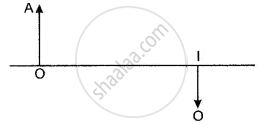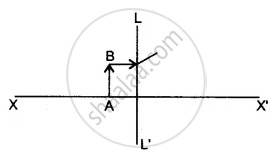Advertisements
Advertisements
Question
A screen is placed a distance 40 cm away from an illuminated object. A converging lens is placed between the source and the screen and its is attempted to form the image of the source on the screen. If no position could be found, the focal length of the lens
Options
must be less than 10 cm
must be greater than 20 cm
must not be greater than 20 cm
must not be less than 10 cm.
Solution
must be greater than 20 cm
Let the image be formed at a distance of x cm from the lens.
Therefore, the distance of the object from the lens, u, will be = (40 − x) cm
From lens formula:
\[\frac{1}{f} = \frac{1}{v} - \frac{1}{u}\]
\[ \Rightarrow \frac{1}{f} = \frac{1}{x} - \frac{1}{40 - x}\]
\[ \Rightarrow \frac{1}{f} = \frac{40 - x - x}{40x - x^2}\]
\[ \Rightarrow f = \frac{40x - x^2}{40 - 2x}\]
\[ \Rightarrow f(40 - 2x) = 40x - x^2 \]
\[ \Rightarrow x^2 - 2fx - 40x + 40f = 0\]
\[ \Rightarrow x^2 - (2f + 40)x + 40f = 0\]
Therefore, we get x as:
\[x = \frac{(2f + 40) \pm \sqrt{(2f + 40 )^2 - 160f}}{2}\]
APPEARS IN
RELATED QUESTIONS
What does sign of power (+ve or –ve) indicate?
Define 1 dioptre of power of a lens.
The lens mentioned in 6(b) above is of focal length 25cm. Calculate the power of the lens.
The power of a lens is + 0.2 D. Calculate its focal length.
What is the nature of a lens whose power is, −4 D?
A doctor has prescribed a corrective lens of power, −1.5 D. Find the focal length of the lens. Is the prescribed lens diverging or converging?
A lens has a focal length of, −10 cm. What is the power of the lens and what is its nature?
The focal length of a lens is +150 mm. What kind of lens is it and what is its power?
An object of height 4 cm is placed at a distance of 15 cm in front of a concave lens of power, −10 dioptres. Find the size of the image.
A convex lens of power 5 D and a concave lens of power 7.5 D are placed in contact with each other. What is the :
(a) power of this combination of lenses?
(b) focal length of this combination of lenses?
Two lenses A and B have focal lengths of +20 cm and, −10 cm, respectively.
(a) What is the nature of lens A and lens B?
(b) What is the power of lens A and lens B?
(c) What is the power of combination if lenses A and B are held close together?
Define power of a lens. Write its units. Deduce the relation `1/f =1/f_1 +1/f_2`for two thin lenses kept in contact coaxially.
A pin of length 2.00 cm is placed perpendicular to the principal axis of a converging lens. An inverted image of size 1.00 cm is formed at a distance of 40.0 cm from the pin. Find the focal length of the lens and its distance from the pin.
How is accommodation produced?
The following diagram shows the object O and the image I formed by a lens. Copy the diagram and on it mark the positions of the lens LL’ and focus (F). Name the lens.

Complete the diagram to show the formation of the image of the object AB.

(i) Name the Lens LL’.
(ii) Where is the image of the object AB formed?
(iii) State three characteristics of the image.
When monochromatic red light is used instead of blue light in a convex lens, its focal length will ______.
The focal length of a double convex lens is equal to the radius of curvature of either surface. What is the refractive index of its material?
